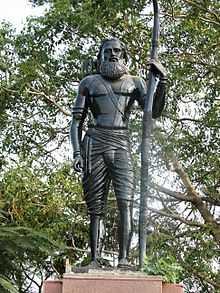Alluri Sitarama Raju
| Alluri Sita Rama Raju | |
|---|---|
 Aggi Pidugu Alluri | |
| Born |
ca. 1897 Possibly Bhimavaram taluk, West Godavari district |
| Died |
7 May 1924 Mampa village in the Visakhapatnam District |
| Title | Manyam Veerudu |
Alluri Sitarama Raju (ca. 1897 – died 7 May 1924) (also known as Aluri Rampa Rama Raju, Rama Chandra Raju, and Alluri Seetharama Raju) was an Indian revolutionary involved in the independence movement.
Raju led the ill-fated "Rampa Rebellion" of 1922–24, during which a band of tribal leaders and other sympathizers fought against the British Raj. He was referred to as "Manyam Veerudu" ("Hero of the Jungles") by the local people.
Early life
Details of Alluri Sita Rama's early life vary. An official report suggests that he was born in 1897 in Bhimavaram taluk, west Godavari district.[1] His mother was from Visakhapatnam and his father was a native of Mogallu, near Bhimavaram. The young Raju lived mainly in Mogallu.[2]
When Raju turned 15, he moved to his mother's home town of Vishakhapatnam and enrolled at Mrs. A. V. N. College.[3]
Rampa Rebellion of 1922
After the passing of the 1882 Madras Forest Act, its restrictions on the free movement of tribal peoples in the forest prevented them from engaging in their traditional "Podu" agricultural system, which involved shifting cultivation.
Raju led a protest movement in the border areas of the East Godavari and Visakhapatnam districts of Andhra Pradesh.[4] Inspired by the patriotic zeal of revolutionaries in Bengal, Raju raided police stations in and around Chintapalle, Rampachodavaram, Dammanapalli, Krishna-devi-peta, Rajavommangi, Addateegala, Narsipatnam and Annavaram.
Raju and his followers stole guns and ammunition and killed several British army officers, including Scott Coward near Dammanapalli.[5]
In December 1922, the British deployed a company of Assam Rifles, near Pegadapalle under the leadership of Saunders. Raju, who had by then gone underground, resurfaced after about four months and continued the fight, strengthened by tribal volunteers using bows and arrows under the leadership of Gam Mallu Dora and Gantam Dora.
Following a raid led by Raju on the Annavaram police outpost on 18 September 1923, Gam Mallu Dora was arrested. The Government entrusted the task of containing Raju's activities to the District Collector of Visakhapatnam district, Rutherford, who fired the first salvo when his forces arrested Surya Narayana Raju Pericherla, popularly known as Aggiraju, a devoted follower of Raju.
The British campaign lasted for nearly a year from December 1922. Rama Raju was eventually trapped by the British in the forests of Chintapalli then tied to a tree and shot dead with a rifle in Mampa village. Following the martyrdom of Alluri, the tribal revolt lost its momentum and petered out by October 1923. Police officer Mr. N. Gnaneswara Rao responsible for Raju's entrapment was awarded Rao Bahadur.
Alluri Sitarama Raju's tomb is present in Krishna devaraya peta (K.D Peta) village.[6]
In popular culture
Today a statue of Raju stands at Seethammadhara Junction and another on the beach road near The Park Hotel in Visakhapatnam. Another was erected in Pandringi, his maternal grandmother's village near Bheemili, about 28 kilometres (17 mi) from Visakhapatnam.
In 1986 the Indian Postal Department issued a commemorative stamp featuring Raju in the series 'India's struggle for freedom'.[7]
The Telugu-language movie Alluri Seetharama Raju depicted Raju's life.
Andhra Pradesh is to celebrate his birthday, 4 July, annually as a state festival.[8]
References
- ↑ Guha, Ranajit (1982). Subaltern studies: writings on South Asian history and society. Oxford University Press. p. 134. Retrieved 4 September 2013.
- ↑ "Vi(zag)nettes". The Hindu. 26 January 2008. Retrieved 10 June 2010.
- ↑ "Sri Alluri Seetarama Raju memorial stamp at Indian Post.com". Indian Post. Retrieved 28 March 2011.
- ↑ Citation Needed
- ↑ Balakrishna, V.G. "Freedom Movement in Andhra Pradesh". Government of India Press Information Bureau. Retrieved 28 March 2011.
- ↑ "Birth anniversary of Alluri celebrated". 5 July 2012. Retrieved 2 February 2015.
- ↑ "Indian Post"
- ↑ "AP to celebrate 117th birthday of Sri Alluri Sitarama Raju". 2 July 2014.
|